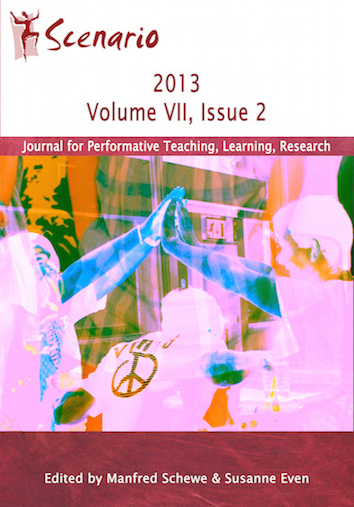Shakespeare in Styria
DOI:
https://doi.org/10.33178/scenario.7.2.6Abstract
This paper offers a professional theatre practitioner’s reflections on directing learners between ages of 16 and 21, and whose first language is not English, in a production of Shakespeare’s Twelfth Night in Murau, Austria, in July 2011. Drawing on links between the theatrical rehearsal and production process and John Biggs’ 3P learning model the author argues in support of performative approaches to L2 study. Suggesting that Shakespeare’s dramaturgy provides uniquely rich and varied pedagogical resources for the L2 learner, the paper presents a case for the use of theatrical performance by students as an element of ESL study.References
Aita, Sean (2010): “Performing England. Language and culture in performative praxis.” In: Nicholson, Helen (ed.) Research in drama education (Vol. 15, Issue 3). London: Routledge, 361-384
Aita, Sean (2009): “The theatre in language learning (TILL) model. Exploring theatre as pedagogy in the L2 Environment,” In: Scenario III/1, 70-89
Barrett, Estelle; Boult, Barbara (2007): Practice as research: approaches to creative arts enquiry. London: I.B. Tauris
Biggs, John (2003): Teaching for quality learning at university. Buckingham: Open University Press
Bristol, Michael (1996): Big Time Shakespeare. London: Routledge
Bould, David; Cohen, Ruth; Sampson, Jane (2001): Peer learning in higher education: learning from & with each other. London: Routledge
Collie, Joanne; Slater, Stephen (1987): Literature in the language classroom: a resource book of ideas and activities. Cambridge: Cambridge University Press
Cheng, Astrid Yi-Mei; Winston, Joe (2011): Shakespeare as a second language: playfulness, power and pedagogy in the ESL classroom. In: Research in Drama Education: The Journal of Applied Theatre and Performance 4: 541-556
Dolati, Romana; Richard, Cameron (2011): Harnessing the use of visual learning aids in the English language classroom. In: Arab World English Journal 2/1, 3-17
Dornyei, Zoltan (1994): Motivation and motivating in the foreign language classroom. In: The Modern Language Journal 3: 273-284
European Shakespeare Days, Shakespeare in Styria. http://www.shakespeare-in-styria.org last accessed Jan 10th, 2012)
Frimberger, Katja (2009): Towards a pedagogy of strangeness. Exploring the potential of strangeness for foreign language Education. In: Scenario III/1: 36-49
McKay, Sandra (1982): Literature in the ESL classroom. In TESOL Quarterly 16: 529-536
Moustakas, Clark (1990): Heuristic research: design, methodology and applications. London: Sage
New Scientist (2012): Learn languages faster with gestures. In New Scientist- Life. http://www.newscientist.com/article/mg21228442.800-learn-language-faster-with-gestures.html#.UokYJ03FLIU (last accessed Nov 18th, 2013)
Paul, Anne M. (2012): What actors can teach us about memory and learning. In Time Ideas. http://ideas.time.com/2012/02/22/what-actors-can-teach-us-about-memory-and-learning/ (last accessed Nov 18th, 2013)
Schewe, Manfred (2013): Taking Stock and Looking Ahead: Drama Pedagogy as a Gateway to a Performative Teaching and Learning Culture. In: Scenario VII/1, 5-27
Staudinger, Eduard; Promitzer, Christian; Hermanik, Klaus-Jürgen (2002): Hidden minorities: Language and ethnic identities in the Alpine-Adriatic region. Strasbourg: European Science Foundation. http://www.theslovenian.com/articles/staudinger.pdf (last accessed Nov 18th, 2013)
Published
Issue
Section
License
Copyright (c) 2013 the author(s)

This work is licensed under a Creative Commons Attribution-NonCommercial-NoDerivatives 4.0 International License.



